Hydrodynamic Behavior of Submerged Floating Tunnels with Suspension Cables and Towers under Irregular Waves
Abstract
:1. Introduction
2. Fluid–Structure Interaction Analysis of SFT under Waves
Governing Equation and Fluid Force of a Submerged Line Element
3. Global Performance of SFTs with Suspension Cables
4. Parametric Study
4.1. Wave Height
4.2. Buoyancy–Weight Ratio (BWR)
4.3. Inclination Angle of the Main Cables
4.4. Diameter of the SFT
4.5. Installation Depth of the SFT
5. Summary and Conclusions
- Wave condition: as the significant wave height increased, the motion of both Type 1 and Type 2 was increased.
- BWR: The behavior of Type 1 and Type 2 differed, depending on the BWR. For Type 2, the acceleration, reaction force, and section force were all increased, as negative motion occurred due to the slack in the BWR 1.1. On the other hand, for Type 1, as the BWR increased, the heave motion increased, and the acceleration, reaction force, and section force increased proportionally.
- Inclination angle of the main cables: it can be seen that the behavior of Type 1 and Type 2 differed, as the inclination angle of the main cables increased. In the case of Type 2, the acceleration, section force, reaction force, etc. increased as the motion in the wave acting direction increased. In contrast, the behavior of Type 1 decreased as the angle increased.
- Diameter of the tube: The acceleration, section force, and reaction force increased as the diameter of the tube grew under the aforementioned conditions. It can be seen that the SFT with the tube of a large dimeter is disadvantageous economically and mechanically.
- Installation depth of the SFT: as the installation depth of the SFT increased, the wave breaking impact generally decreased, and the motion decreased. However, in the case of a depth of 40 m, Type 2 experienced slack, and the acceleration, section force and reaction force were greatly increased, which is a condition that should be avoided.
- Comprehensive remarks: overall, it can be seen that the Type 2 SFT was superior from a hydrodynamic point of view. However, a detailed hydrodynamic analysis must be performed to avoid the conditions that previously produced slack. In addition, in the case of acceleration being generated by motion, the design should be reviewed to ensure safe conditions, according to the traffic passage.
Author Contributions
Funding
Conflicts of Interest
Abbreviations
| the cross-sectional area | |
| the added mass coefficient (with a cross-sectional area as a reference area) | |
| the drag coefficient | |
| the diameter | |
| the sectional drag force | |
| a loft force | |
| normal force | |
| a tangential force | |
| a torsion moment | |
| the fluid particle (waves and/or current) velocity | |
| the fluid particle acceleration | |
| the mass density of the fluid | |
| the wavelength |
References
- Zanchi, F. Archimedes Bridge; Floornature: Naple, Italy, 2002. [Google Scholar]
- Martire, G. The Development of Submerged Floating Tunnels as an Innovative Solution for Waterway Crossings. Ph.D. Thesis, Construction Engineering, University of Naples “Federico II”, Naples, Italy, 2010. [Google Scholar]
- Mazzolani, F.M.; Landolfo, R.; Faggiano, B.; Esposto, M.; Martire, G.; Perotti, F.; Di Pilato, M.; Barbella, G.; Fiorentino, A. The Archimede’s Bridge Prototype in Qiandao Lake (PR of China)—Design Report; Research Project Report; Sino-Italian Joint Laboratory of Archimedes Bridge (SIJLAB): Qiandao, China, 2007. [Google Scholar]
- NPRA (Norwegian Public Roads Administration). A Feasibility Study—How to Cross the Wide and Deep Sognefjord; Norwegian Public Roads Administration: Western Region, Oslo, Norway, 2011. [Google Scholar]
- Lin, H.; Xiang, Y.Q.; Yang, Y.S. Vehicle-tunnel coupled vibration analysis of submerged floating tunnel due to tether parametric excitation. Mar. Struct. 2019, 67. [Google Scholar] [CrossRef]
- Xiang, Y.Q.; Yang, Y. Spatial dynamic response of submerged floating tunnel under impact load. Mar. Struct. 2017, 53, 20–31. [Google Scholar] [CrossRef]
- Seo, S.I.; Mun, H.S.; Lee, J.H.; Kim, J.H. Simplified analysis for estimation of the behavior of a submerged floating tunnel in waves and experimental verification. Mar. Struct. 2015, 44, 142–158. [Google Scholar] [CrossRef]
- Xiang, Y.Q.; Chen, Z.Y.; Yang, Y.; Lin, H.; Zhu, S. Dynamic response analysis for submerged floating tunnel with anchor-cables subjected to sudden cable breakage. Mar. Struct. 2018, 59, 179–191. [Google Scholar] [CrossRef]
- Lu, W.; Ge, F.; Wang, L.; Wu, X.D.; Hong, Y.S. On the slack phenomena and snap force in tethers of submerged floating tunnels under wave conditions. Mar. Struct. 2011, 23, 358–376. [Google Scholar] [CrossRef] [Green Version]
- Jin, C.; Kim, M.H. Time-Domain Hydro-Elastic Analysis of a SFT (Submerged Floating Tunnel) with Mooring Lines under Extreme Wave and Seismic Excitations. Appl. Sci. 2018, 8, 2386. [Google Scholar] [CrossRef] [Green Version]
- Chen, Z.Y.; Xiang, Y.Q.; Lin, H.; Yang, Y. Coupled Vibration Analysis of Submerged Floating Tunnel System in Wave and Current. Appl. Sci. 2018, 8, 1311. [Google Scholar] [CrossRef] [Green Version]
- Won, D.; Kim, S. Feasibility Study of Submerged Floating Tunnels Moored by an Inclined Tendon System. Int. J. Steel Struct. 2018, 18, 1191–1199. [Google Scholar] [CrossRef]
- Veritas, D.N. DNV-RP-C205 Environmental Conditions and Environmental Loads; Det Norske Veritas: Oslo, Norway, 2010. [Google Scholar]
- Simulia Inc. ABAQUS 6.14 User’s Manual; Dassault Systems: Providence, RI, USA, 2014. [Google Scholar]
- Hasselmann, K.; Barnett, T.P.; Bouws, E.; Carlson, H.; Cartwright, D.E.; Enke, K.; Ewing, J.A.; Gienapp, H.; Hasselmann, D.E.; Kruseman, P.; et al. Measurements of wind-wave growth and swell decay during the Joint North Sea Wave Project (JONSWAP); Ergnzungsheft zur Deutschen Hydrographischen Zeitschrift Reihe: Delft, The Netherland, 1973. [Google Scholar]
- Kim, S.; Park, W.S.; Won, D. Hydrodynamic Analysis of Submerged Floating Tunnel Structures by Finite Element Analysis. J. Korean Soc. Civ. Eng. 2016, 36, 955–967. [Google Scholar] [CrossRef] [Green Version]
- Oh, S.H.; Park, W.S.; Jang, S.C.; Kim, D.H. Investigation on the behavioral and hydrodynamic characteristics of submerged floating tunnel based on regular wave experiments. J. Korean Soc. Civ. Eng. 2013, 33, 1887–1895. [Google Scholar] [CrossRef]
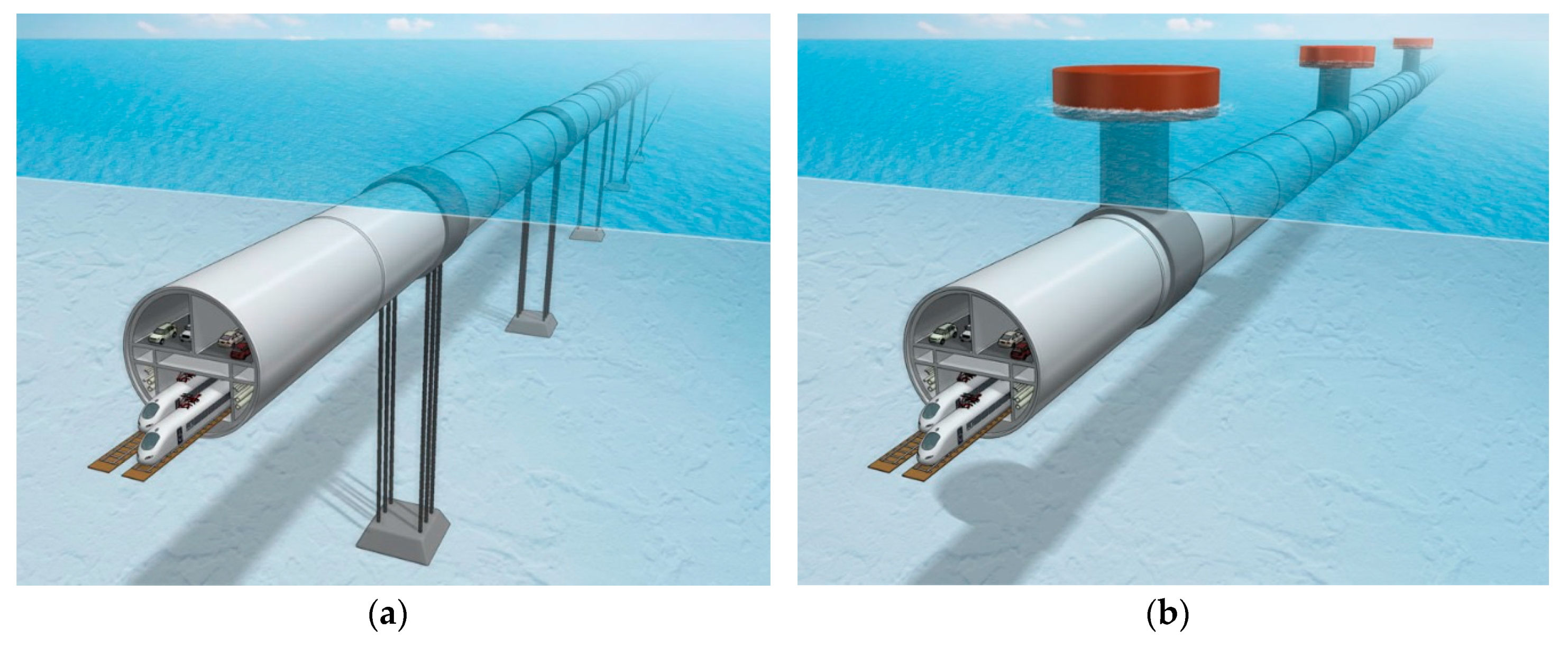
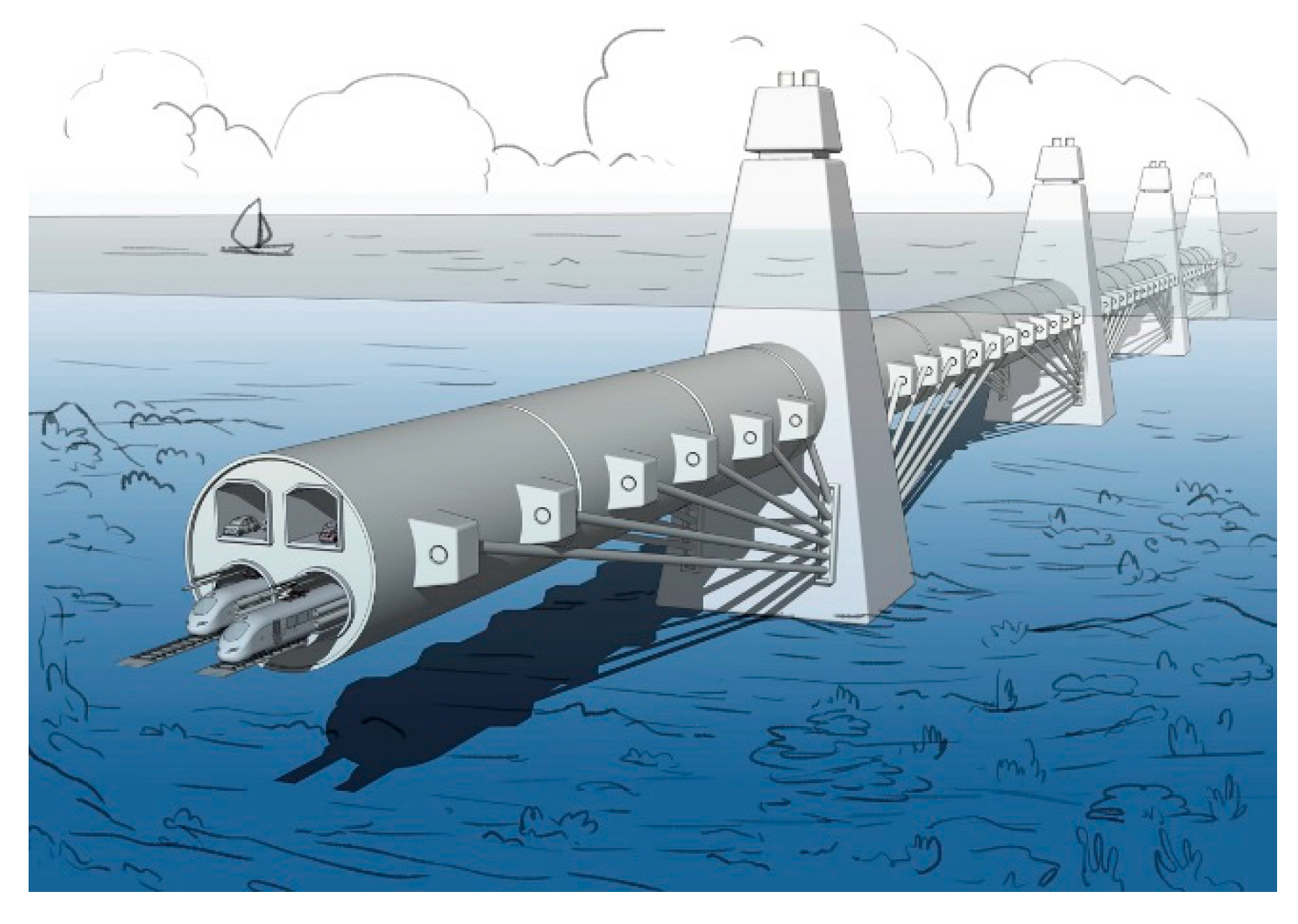
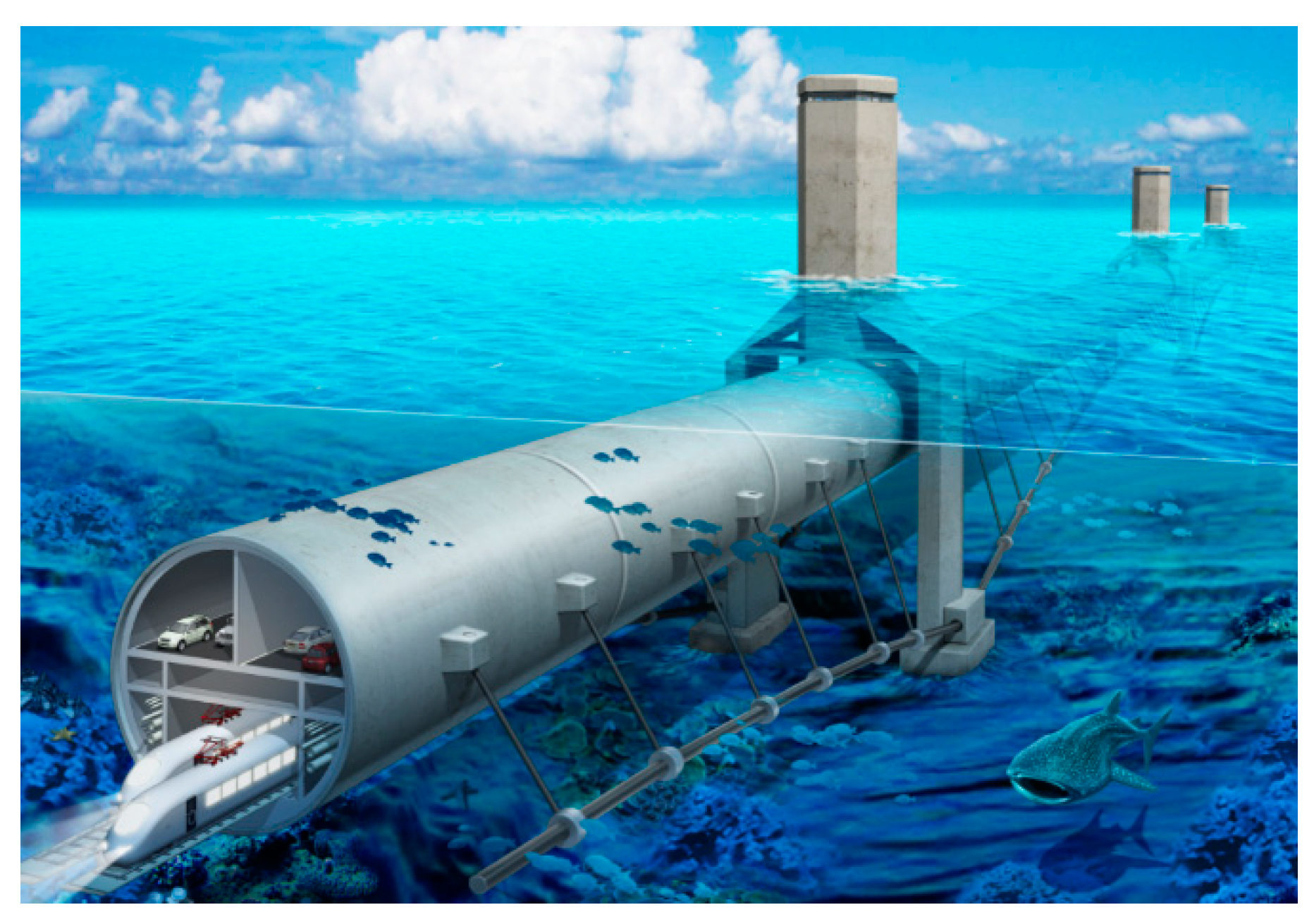

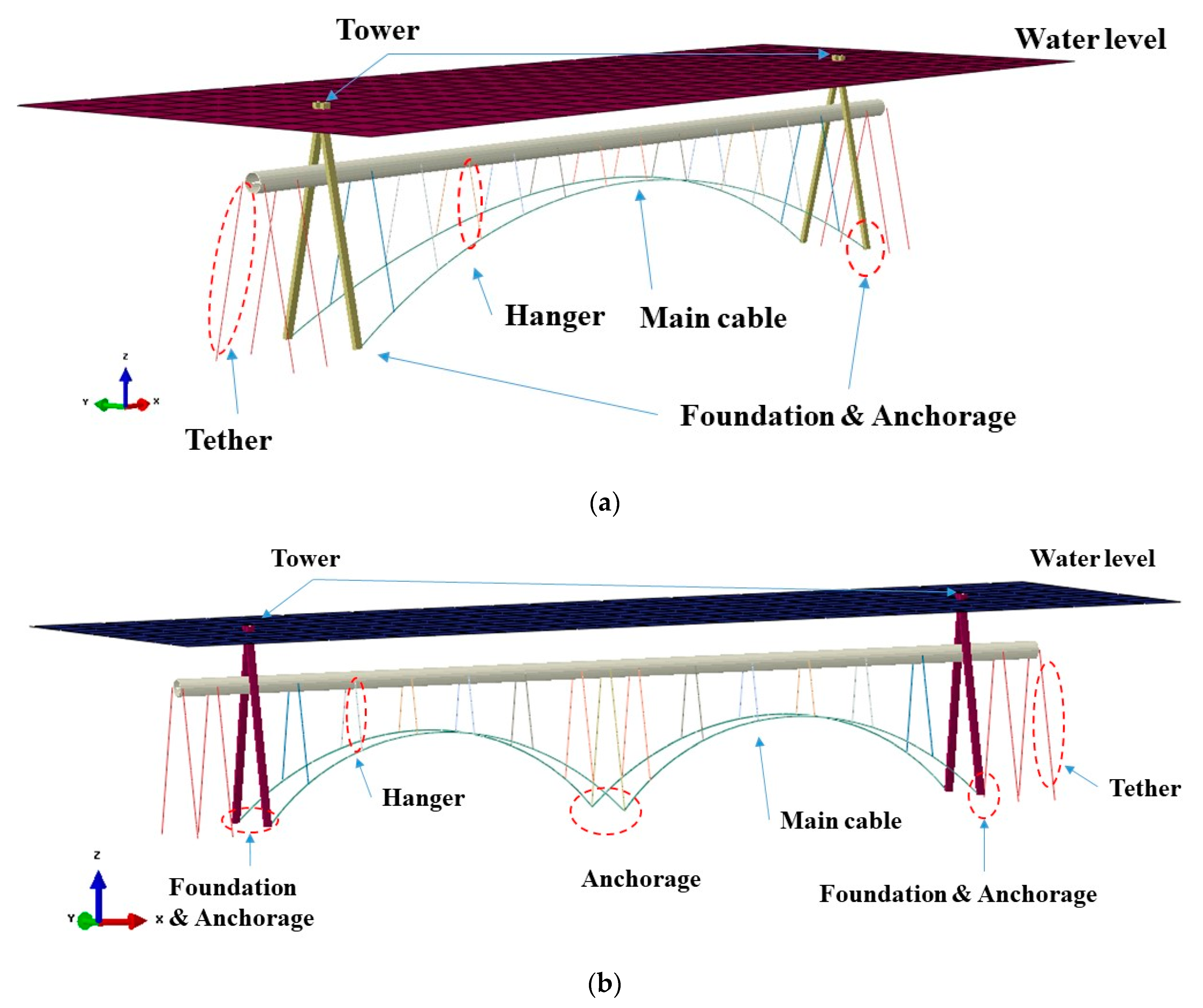
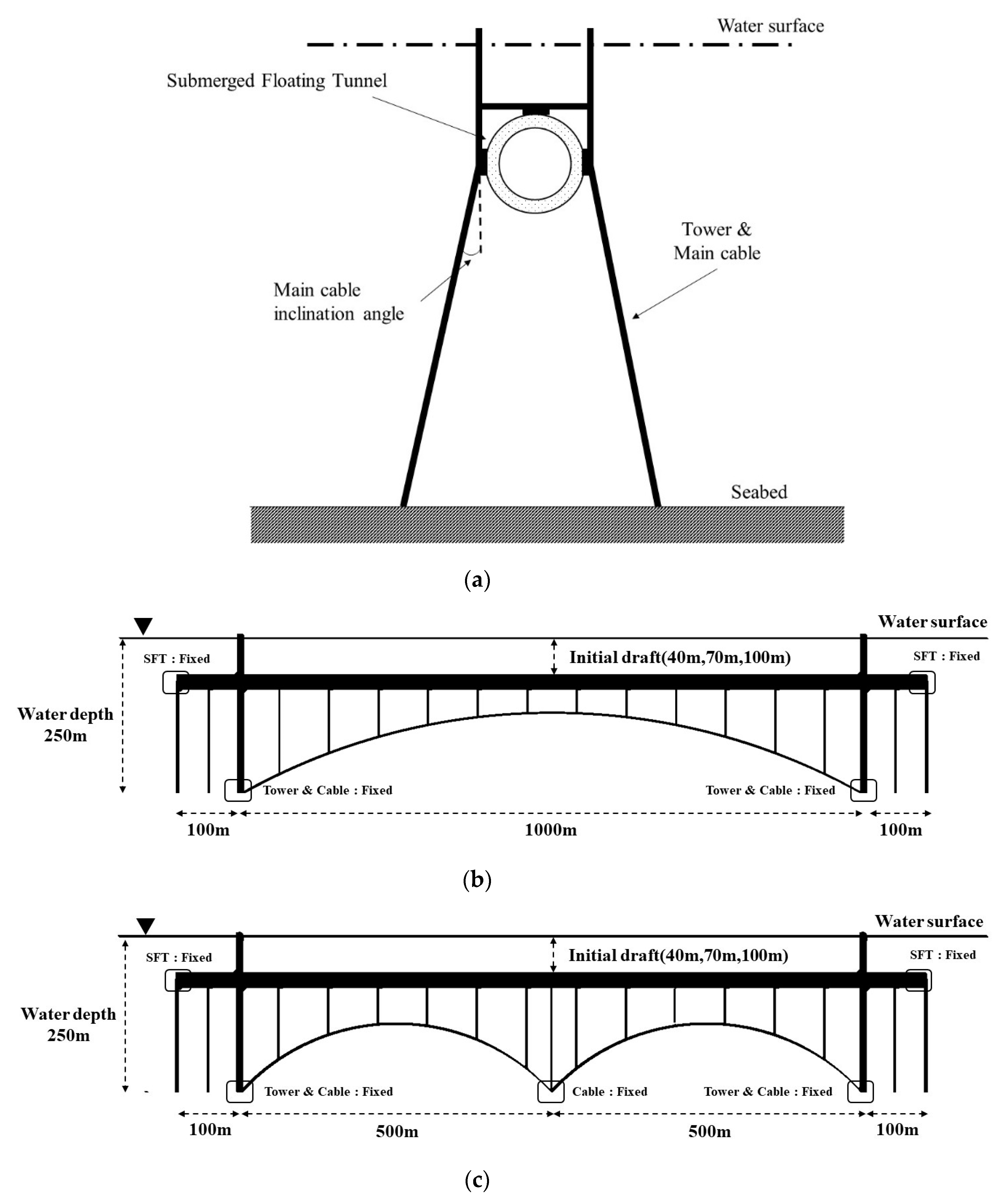











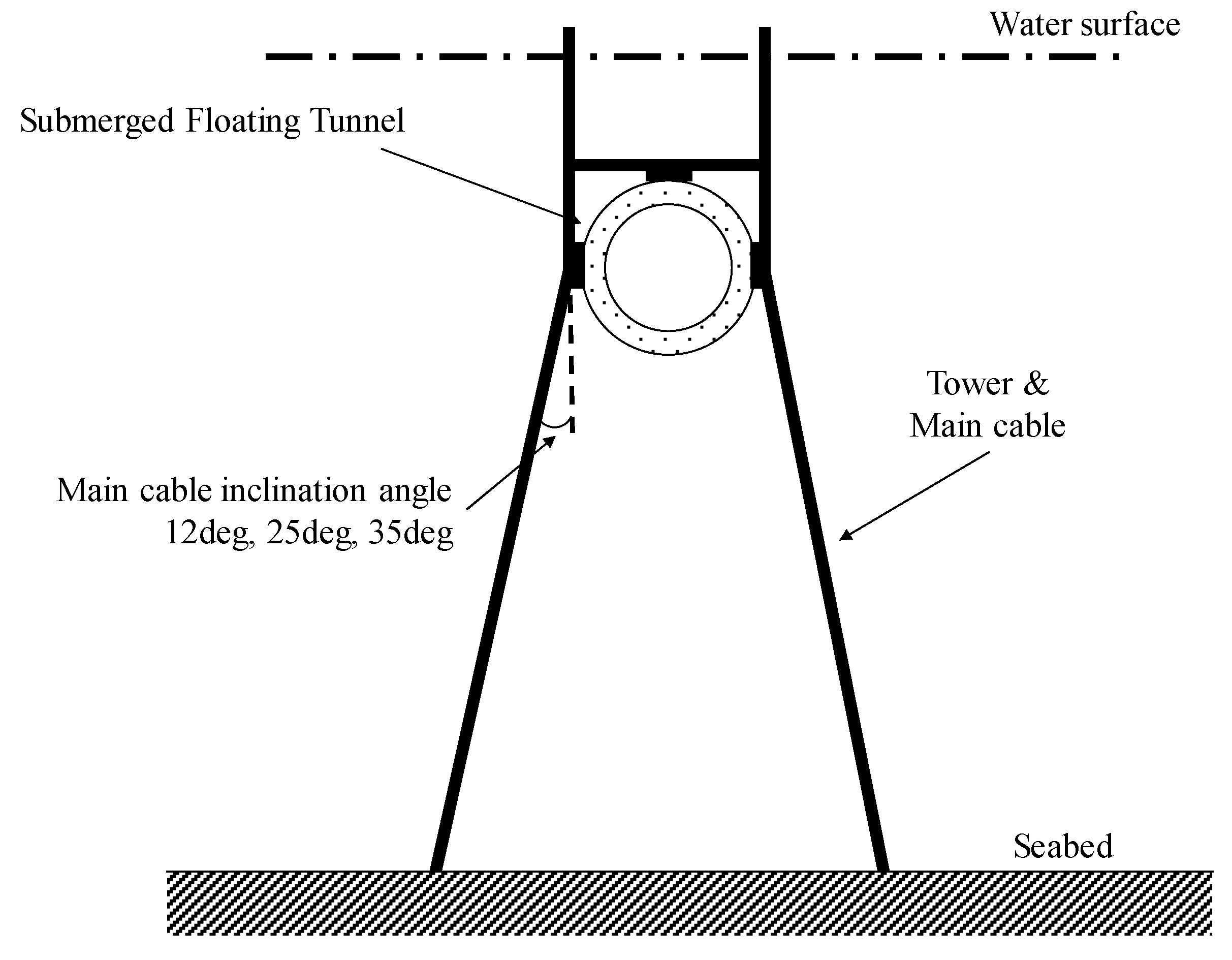








| Parameters | Values |
|---|---|
| Environmental condition | |
| Water depth (m) | 280 |
| Peak wave period (Tp, s) | 5, 8, 10 |
| Significant wave height (Hs, m) | 3.5, 6.0, 8.0 |
| Tube | |
| Outer diameter (m) | 17, 20, 23 |
| Thickness of SFT (m) | 1 |
| Span length (m) | 1000 |
| Drag/added mass coefficient | 1.2/1.0 |
| Installation depth (m) | 40, 70, 100 |
| Main cable (wire, spiral with sheathing) | |
| Outer diameter (m) | 0.4 |
| Cross sectional area (m2) | 0.125 |
| Elastic modulus (GPa) | 205 |
| Minimum yield stress (MPa) | 1180 |
| Maximum yield stress (MPa) | 1570 |
| Drag/added mass coefficient | 1.2/1.0 |
| Inclination angle | 12, 25, 35 |
| Hanger (wire, spiral with sheathing) | |
| Outer diameter (m) | 0.32 |
| Cross sectional area (m2) | 0.08 |
| Elastic modulus (GPa) | 205 |
| Minimum yield stress (MPa) | 1180 |
| Maximum yield stress (MPa) | 1570 |
| Drag/added mass coefficient | 1.2/1.0 |
| Side tether | |
| Outer diameter (m) | 0.379 |
| Cross sectional area (m2) | 0.113 |
| Elastic modulus (GPa) | 210 |
| Minimum yield stress (MPa) | 482.6 (API X70) |
| Maximum yield stress (MPa) | 565.4 (API X70) |
| Drag/added mass coefficient | 1.2/1.0 |
| Tower | |
| Width × Height × Thickness (m) | 10 × 5 × 1 |
| Compressive strength (MPa) | 35 |
| Elastic Modulus (GPa) | 28.066 |
| Type 1 | Type 2 | |||
|---|---|---|---|---|
| Min (MN) | Max (MN) | Min (MN) | Max (MN) | |
| BWR 1.1 | 17.1 | 33.7 | –2.82 | 12.6 |
| BWR 1.2 | 62.5 | 92.5 | 0.289 | 8.26 |
| BWR 1.3 | 114.0 | 148.0 | 3.57 | 9.55 |
© 2019 by the authors. Licensee MDPI, Basel, Switzerland. This article is an open access article distributed under the terms and conditions of the Creative Commons Attribution (CC BY) license (http://creativecommons.org/licenses/by/4.0/).
Share and Cite
Won, D.; Seo, J.; Kim, S.; Park, W.-S. Hydrodynamic Behavior of Submerged Floating Tunnels with Suspension Cables and Towers under Irregular Waves. Appl. Sci. 2019, 9, 5494. https://doi.org/10.3390/app9245494
Won D, Seo J, Kim S, Park W-S. Hydrodynamic Behavior of Submerged Floating Tunnels with Suspension Cables and Towers under Irregular Waves. Applied Sciences. 2019; 9(24):5494. https://doi.org/10.3390/app9245494
Chicago/Turabian StyleWon, Deokhee, Jihye Seo, Seungjun Kim, and Woo-Sun Park. 2019. "Hydrodynamic Behavior of Submerged Floating Tunnels with Suspension Cables and Towers under Irregular Waves" Applied Sciences 9, no. 24: 5494. https://doi.org/10.3390/app9245494
APA StyleWon, D., Seo, J., Kim, S., & Park, W.-S. (2019). Hydrodynamic Behavior of Submerged Floating Tunnels with Suspension Cables and Towers under Irregular Waves. Applied Sciences, 9(24), 5494. https://doi.org/10.3390/app9245494







